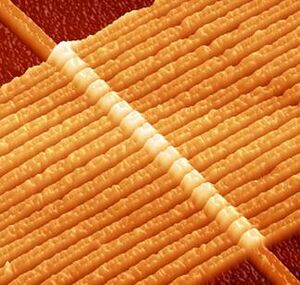Memristor facts for kids
A memristor is a special electronic part. It's like a resistor, but it also has a memory! Think of it as a "memory resistor." It's considered one of the basic building blocks of electronic circuits, just like a resistor, capacitor, or inductor. What makes it unique is that no combination of these other parts can do what a memristor does.
A memristor can change how easily electricity flows through it (its electrical resistance) based on the voltage applied. The amazing part is that it remembers this change even after the power is turned off. It can act like a memory that stores information or a switch that can have many different settings.
History of Memristors
A smart professor named Leon Chua first described the idea of a memristor in 1971. He used math to show that such a device should exist.
It took many years for scientists to find a real material that could act like a memristor. In 2008, scientists at HP Labs announced they had found a material that behaved just like the memristor Professor Chua had described. This was a big step forward!
This special electronic part can change how well it conducts electricity. Even after the power is gone, it remembers its last setting. This means it can store information without needing constant power. This ability to "remember" makes memristors very similar to how nerve cells (neurons) in our brains work.
Future Uses for Memristors
Memristors could change how computers work in the future. Today, when you turn off a computer, it loses all the information in its main memory. That's why computers have to "boot up" from the hard drive every time you turn them on. This process takes time and uses energy.
Memristors could solve this problem. Because they remember data even after the power is off, computers could start up much faster. Imagine turning on your computer and it's ready to go instantly! This could save a lot of time and energy.
The first products using memristor technology were expected to be available around 2013. Scientists are still working on new ways to use these amazing memory resistors.
Images for kids
See also
 In Spanish: Memristor para niños
In Spanish: Memristor para niños



